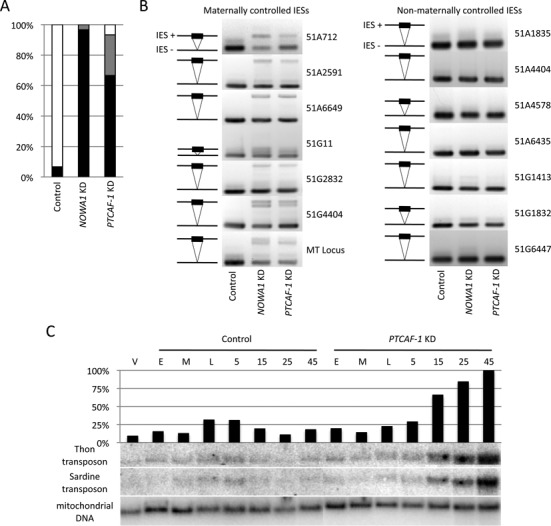Figure 2.

Effect of PTCAF-1 knockdown on cell survival, IES and transposon retention. (A) Effect of PTCAF-1 knockdown on cell survival. After going through autogamy in silencing medium the cells where recovered in WGP medium. The graph shows the survival after three days. Black: percentage of dead cells; grey: percentage of sick cells showing an altered number of divisions or behavior; white: percentage of cell growing at a normal rate. NOWA1 KD was used as a positive control. Silencing vector without insert was used as negative control. (B) Effect of PTCAF-1 knockdown on IES excision. IES retention was tested by PCR using primers flanking specific IESs sequences within the 51G and 51A genes as well as the mating-type locus (MT Locus). The excised form (IES−) is always detectable due to its presence in the fragments of the parental MAC. The unexcised form (IES+) is only detectable in case of retention in the newly developing macronuclei. Maternally controlled IESs: 51A712, 51A2591, 51A6649, 51G11, 51G2832, 51G4404, MT-Locus; non-maternally controlled IESs: 51A1835, 51A4404, 51A4578, 51A6435, 51G1413, 51G1832, 51G6447. (C) Effect of PTCAF-1 KD on Thon and Sardine transposons. Total DNA was extracted from vegetative (V), control and PTCAF-1 KD cultures at specific time points during sexual reproduction. E, M, L as in Figure 1C; 5, 15, 25 and 45 h after L. After running the DNA on a 1% agarose-gel and transfer to nylon membrane the samples were hybridized with Sardine and Thon transposon-specific probes. A mitochondrial DNA-specific probe was used as loading control. The graph shows the Thon signal quantification normalized to the loading control.
